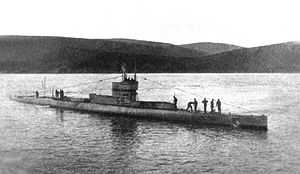HMS G3
 A G class submarine before bow modification. Photo: R N Submarine Museum, Gosport. | |
| Career | |
|---|---|
| Builder: | Chatham Dockyard |
| Laid down: | 1 October 1914 |
| Launched: | 22 January 1916 |
| Commissioned: | 13 April 1916 |
| Fate: | Sold for scrap 4 November 1921 to Young, Sunderland, she was wrecked in Filey Bay after breaking her tow the following month. |
| General characteristics | |
| Displacement: | Surfaced / Submerged: 703 tons / 837 tons |
| Length: | 57.5 m |
| Beam: | 6.92 m |
| Draught: | 4.15 m |
| Propulsion: | Twin-shaft, 2 x 800 bhp Vickers diesel, 2 x 840 shp electric motors |
| Speed: | Surfaced / Submerged: 14.5 knots (27 km/h) / 10.0 knots |
| Range: | 44.14 tons of fuel oil giving 3,160 nm surfaced at 10 knots (19 km/h). 95 nm submerged, at 3 knots (6 km/h). |
| Complement: | 31 |
| Armament: | Torpedoes: 2 x 18" bow tubes, 2 x 18" beam tubes, 1 x 21" stern tube. 10 torpedoes in total. Guns: 1 x 3" 10 cwt. Mk.1 Elswick Quick Fire High Angle {QFHA}, forward. 1 x 12 pdr. 8 cwt. Mk. 1 gun HA mounting, aft. |
HMS G3 was a British G class submarine of the Royal Navy from World War I.
War service
Like the rest of her class, G3's role was to patrol the North Sea in search of German U-boats.
Fate
In December 1921 G3, out of commission, was being towed north to be broken up for scrap when she broke her tether and came ashore at Scalby Mills, north of Scarborough.
The submarine later broke free from the shore and drifted back out to sea. She then drifted south, finally running aground under Buckton cliffs in Filey Bay, bow first. A local man bought the salvage rights to the vessel and the wreck was scrapped. Lumps of the hulk were lifted up the sheer cliffs using ropes and pulleys, the salvers using rope ladders for access.
The remains of the wreck lie under the cliffs at Buckton including about 60 feet (18 m) of the base of the hull, two diesel engines and their drive gear.
References
- Colledge, J. J.; Warlow, Ben (2006) [1969]. Ships of the Royal Navy: The Complete Record of all Fighting Ships of the Royal Navy (Rev. ed.). London: Chatham Publishing. ISBN 978-1-86176-281-8. OCLC 67375475.
External links
| ||||||||||